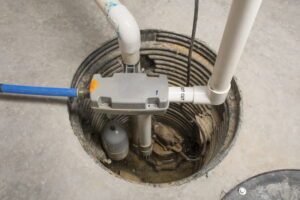The sump pump in your home is crucial during the rainy spring season. A sump pump in good order will help to prevent damage from flooding, both to your home and your possessions. But before you start to rely on your sump pump for another season, you need to know that it’s working right. A preventive device like a sump pump isn’t much good if you can’t trust that it will work when it needs to.
Take this time now to test your sump pump. That way you’ll find out in time if you need to call for repairs or a replacement.
The Steps to Test Your Sump Pump
Don’t know how to test your sump pump? No problem, we’ve got a step-by-step guide.
- Safety First: Before you start any work, ensure your sump pump is unplugged to prevent electrical accidents. Wear gloves if you prefer to keep your hands clean during the process.
- Inspect the Sump Pump: Examine the sump pump for any visible signs of damage, debris, or blockages. Clear away any obstructions around the pump. Check the power cord for any fraying or damage. Don’t test the pump if this cord is damaged.
- Check the Discharge Pipe: Inspect the discharge pipe to ensure it is securely connected and free from obstructions. Remove any debris or dirt that may have accumulated.
- Verify the Float Switch: Gently lift the float switch to ensure it moves freely. It should trigger the pump to turn on and off smoothly. If the float switch is damaged or stuck, you may need to have it replaced.
- Inspect the Check Valve: Locate the check valve along the discharge pipe and ensure it is properly installed and not damaged. Confirm that the valve allows water to flow in one direction only.
- Pour Water into the Sump Pit: Fill a bucket with water, then slowly pour the water into the sump pit until the float is lifted, simulating rising water levels.
- Monitor Pump Activation: Observe the pump’s response to the rising water. The pump should activate automatically as the float rises. Listen for any unusual noises during operation.
- Check Discharge: Confirm that water is being pumped out through the discharge pipe. If the water is being expelled outside and not into the wastewater system or septic tank, make sure the water isn’t too close to your home’s foundation
- Inspect for Leaks: Check for any leaks around the pump, connections, or discharge pipe.
- Verify Proper Shut-Off: Once the water level decreases, the pump should turn off automatically. Ensure the float switch returns to its original position.
- Reconnect Power: Plug the sump pump back into its power source. You’re done!
If Something Is Wrong…
You did the check on the sump pump, but something isn’t right. The pump isn’t activating, or it won’t shut off, or it’s leaking. Now you’ll need to call for professional sump pump repair in Greenville, SC. In some cases, the sump pump might be too old or damaged for repairs, and the whole unit will need to be replaced.
Contact Carolina Climate Control for sump pump repairs and maintenance. The Moose Is Loose in Your Neighborhood!

